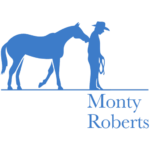Excerpt from Chapter 9 of Monty’s textbook, From My Hands to Yours.
To obtain your own copy of Monty’s textbook, please CLICK HERE.
Even if you have no connection with racing, you can still benefit greatly from this section on the behavior of horses when we ask them to habituate to the starting gates, because these principles are applicable to equine behavior in all disciplines, including leisure riding.

I have worked extensively with horses that have problems with starting gates (also known as starting stalls). I travel to all parts of the world to work with racehorses that have become negative at the starting gate because their inherent nature is misunderstood and because of the subsequent use of force meted out by track workers. It is far more difficult to deal with horses that have taken the law into their own hands than it is to deal with the young and unspoiled.
For decades now, most equestrians involved in this process have used extrinsic training. I define extrinsic training as the attempt to force knowledge on the student. It is external to the brain of the student. Intrinsic training lets the brain of the student learn from within. This allows the student to draw into the brain information voluntarily. This is a far more effective way of learning than when information is forced upon you from external sources. In fact, most horses will be broken to comply with the demands made of them. Some, however, will resent this harsh treatment and become phobicly resistant to the starting gate. These are the ones I am asked to reform.
When a racehorse first enters the starting gate, feeling the sidewalls intruding into the area of his flanks, his natural reaction is to lean into what he perceives to be a life-threatening situation. Often the jockey or handler will whip the horse in an attempt to punish him for this behavior. This simply serves to convince the horse that the starting gate is a dangerous place to be. He might think there is a big cat in there with claws and teeth or a flying predator. Following this experience, the horse’s tendency is to resist loading into the gates at any cost. Man’s tendency is to then force him by various means. He might use whips, twitches, lip chains, or a combination of these things in an attempt to demand compliance. Trying to force a horse is usually unsuccessful, and goes against every tenet of my concepts. The larger the horse, the more likely the gates will feel intrusive.
There are two types of problems in this area. One is caused by incorrect schooling, which usually includes fear and pain, and the other problem is caused by the fact that the horse is innately an into-pressure animal.
To obtain your own copy of Monty’s textbook and read the rest of this chapter, please CLICK HERE.

